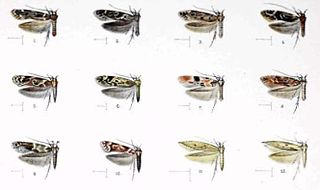
Hyposmocoma auropurpurea is a species of moth of the family Cosmopterigidae. It was first described by Lord Walsingham in 1907. It is endemic to the Hawaiian island of Oahu. The type locality is the Waianae Range.

Hyposmocoma inversella is a species of moth of the family Cosmopterigidae. It was first described by Lord Walsingham in 1907. It is endemic to the Hawaiian island of Oahu. The type locality is the Waianae Range, where it was collected at an elevation of 2,000 feet (610 m).
Hyposmocoma trifasciata is a species of moth of the family Cosmopterigidae. It was first described by Otto Swezey in 1915. It is endemic to the island of Hawaii. The type locality is Laupāhoehoe.

Hyposmocoma subcitrella is a species of moth of the family Cosmopterigidae. It was first described by Lord Walsingham in 1907. It is endemic to the Hawaiian island of Kauai. The type locality is Kaholuamano, where it was collected at an elevation of 4,000 feet (1,200 m).
Hyposmocoma laysanensis is a species of moth of the family Cosmopterigidae. It is endemic to Laysan. The type locality is Guano Rock.
Hyposmocoma laysanensis is a species of moth of the family Cosmopterigidae. It is endemic to Laysan. The type locality is Guano Rock.
Hyposmocoma opuumaloo is a species of moth of the family Cosmopterigidae. It is endemic to Necker Island. The type locality is Flagpole Hill.
Hyposmocoma mokumana is a species of moth of the family Cosmopterigidae. It is endemic to Necker Island. The type locality is Annexation Hill.
Hyposmocoma nihoa is a species of moth of the family Cosmopterigidae. It is endemic to Nihoa, Northwestern Hawaiian Islands. The type locality is Miller Canyon.
Hyposmocoma kikokolu is a species of moth of the family Cosmopterigidae. It is endemic to Nihoa. The type locality is Miller Canyon.
Hyposmocoma menehune is a species of moth of the family Cosmopterigidae. It is endemic to Nihoa. The type locality is Miller Canyon.
Hyposmocoma papahanau is a species of moth of the family Cosmopterigidae. It is endemic to Nihoa, Northwestern Hawaiian Islands. The type locality is Miller Canyon.
Hyposmocoma carnivora is a species of moth of the family Cosmopterigidae. It is endemic to Hawaii.
Hyposmocoma pupumoehewa is a species of moth of the family Cosmopterigidae. It is endemic to Maui.
Hyposmocoma eliai is a species of moth of the family Cosmopterigidae. It is endemic to Kauai. Larvae were collected on large barren volcanic rocks placed along the shoreline to reduce erosion in Nawiliwili bay.
Hyposmocoma opuulaau is a species of moth of the family Cosmopterigidae. It is endemic to Maui.
Hyposmocoma nohomaalewa is a species of moth of the family Cosmopterigidae. It is endemic to Kauai.
Hyposmocoma pukoa is a species of moth of the family Cosmopterigidae. It is endemic to Maui.
Hyposmocoma wahikanake is a species of moth of the family Cosmopterigidae. It is endemic to Lanai.
Hyposmocoma waikamoi is a species of moth of the family Cosmopterigidae. It is endemic to Maui.


